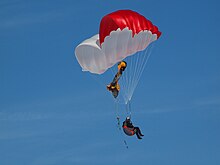Francis Rogallo
Francis Melvin Rogallo (born January 27, 1912 in Sanger , California , † September 1, 2009 in Southern Shores , Dare County , North Carolina ) was an American aerodynamicist . Rogallo became known for the development and patenting of flexible wings , also known as Rogallo wings , after World War II.
Act
While initially only a toy factory produced flexible children's kites according to his best-known patent , in 1960 he became head of a research program at NASA in connection with the ambitious space projects in the USA , where he was mainly concerned with the development and testing of flexible kites until the early 1970s when re-entering the earth's atmosphere self-unfolding wings.
The basis for this was ultimately the conceptual ideas laid down in a patent by his wife Gertrude and him as early as 1948 for flexible wings consisting only of fabric and cord (see also paraglider ). The decisive difference to the round-cap parachutes of the time , which were also made of fabric and cords, were the u. a. gliding properties achieved by the different shape of his devices.
In addition to the well-known "Rogallo" triangular shape, the patent also contained the description of a second basic shape, in which "fabric tubes open to the front, arranged parallel to each other and inflated by the airstream, form a wing". While extensive experiments in practice followed with Rogallo parachutes , such parachutes for special purposes (e.g. as rescue parachutes ) are still in use today and this umbrella concept ultimately also forms the basis for kites that unfold in the air, which NASA is involved in Loads weighing tons, as well as representing the basic shape of today's hang-gliders , concrete implementations of Rogallo's second idea are not known. However, their theoretical foundations were incorporated into later patents: After the Rogallo patent was settled and released by NASA in 1964, Domina Jalbert registered a corresponding box or mattress-shaped multi-cell parachute concept ( parafoil ) with which he was on a own patent of a special multi-cell parachute from January 1st, 1963, but also based on Rogallo's ideas. All today's wing parachutes and paragliders are based on this principle by Jalbert, so that Rogallo, in addition to his key role in the history of hang gliders, undoubtedly also has a role in their history.
At the beginning of the 1960s, Dornier took up the idea under the name Project 621 and wanted to realize a reusable sounding rocket that would return to earth on a Rogallo wing, also known as parawing. Various models of the grand piano were built and tested before the program was discontinued in 1965.
See also
Individual evidence
| personal data | |
|---|---|
| SURNAME | Rogallo, Francis |
| ALTERNATIVE NAMES | Rogallo, Francis Melvin |
| BRIEF DESCRIPTION | American aerodynamicist |
| DATE OF BIRTH | January 27, 1912 |
| PLACE OF BIRTH | Sanger , California |
| DATE OF DEATH | September 1, 2009 |
| Place of death | Southern Shores , North Carolina |


